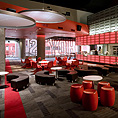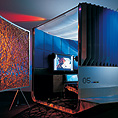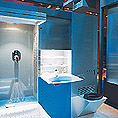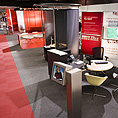











Creating Culture ExhibitionNew Parliament House, Canberra. August 1994This exhibition, staged in conjunction with the Creating Culture - The New Growth Industries conference, sets out to challenge our preconceived notions of cultural industries, stretching the boundaries of current definitions. It zeroes in on new information technology, placing it firmly among the cultural industries. In the desire to stimulate and provoke response, each component requires interactivity - without seeking o threaten or intimidate. |
But the abstract, conceptualised elements of the exhibition are set in a very physical landscape, establishing a conjunction of the ethereal and the the material. A different space has been created in the building not only to make the experience of the conference unique, but also to say 'here is creative intervention'. |
It is not only an exhibition of new information technology and its cultural connection, but it is also a total composition incorporating architectural, graphic design, interior design and environmental elements. |
Blue Screens |
The screens are the component which flag the entry to the exhibition. They are intended to draw people into the conference. |
The luminous colour and light sensitivity to human movement provide an excitement and unpredictability at the very start of the exhibition and they hepl define the location within the vastness of the building. They are friendly, optimistic, colourful and bright; thay are not about setting things in concrete, but exploring ideas, anticipating direction into the 21st century. At the same time, the soft curves generated by the fabric give them a slightly organic nature. |
 |
Red TV Monitor Wall and Orange Graphics Wall |
Again, the colours are very bright with an unlikely juxtaposition of colour. Through large cut outs in the first wall are glimpsed parts of the words relating to the cultural industries and the themes of the conference - growth, export, future. But as you progress towards the walls, your perception shifts, allowing other views of the text. |
Your progress also reveals that the walls are not confrontational and blocking, but in fact create a path through to the rest of the exhibition and reveal a completely different sense of space beyond. |
The video screening on the monitor wall explores the extraordinary range of Australian creativity. It is impressionistic, designed to muse upon - it is not literal, not a shopping catalogue. |
The Meeting Area |
The room has been converted into a landscape by producing a field of pylons and placing the cocoons in this field. It's landscape of ideas and future possibilities. |
The pylons refer to both the landscape, through the river rocks they are embedded in, and to fibre optics and optical communication, through the flexible, perspex rods. They are landscape for social exploration, with the cocoons presenting a more private investigation space. |
Green and Puprle Cocoons |
These are the important foci of the exhibition. The two pavillions create a communication nexus for the interactive programs. The viewing environment is both different and intimate. |
At first glance it appears the cocoons are solid, but on closer inspection, the ramp-passagewat between the two parts is exposed. The convex wall of the first structure radiates its four monitors out into the main body of the room while the concave outer face of the second is directed into the corner of the foyer and provides a more sheltered viewing space for the TV monitors. |
2008 © Crowd

